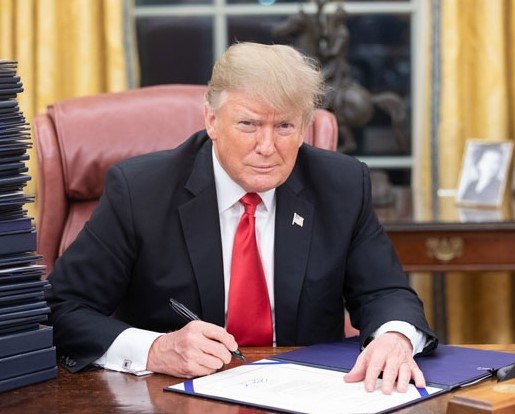New White House directives signal a dramatic pivot in U.S. tech policy, eyeing global dominance and domestic culture war wins
President Donald Trump wants American-made artificial intelligence to win — not just at home, but everywhere. On Wednesday, he signed three executive orders aimed at transforming the country into an AI superpower while aggressively scrapping what he calls the “woke” leanings of current algorithms.
The move sets the tone for what could be one of the most defining policy shifts of his second term: fewer guardrails, faster exports, and a sharp cultural reset for how AI systems behave and interact with users.
Three orders, one message: full-speed ahead on American AI
At a brief but highly publicized signing ceremony, Trump laid out his case. He said the U.S. had “fallen behind” during the Biden years and that now was the time to act before China or the EU grabbed the lead. His executive orders aim to do the following:
-
Order 1: Remove what the White House calls “ideological filters” from federally funded AI models, effectively banning training practices focused on DEI (Diversity, Equity, Inclusion).
-
Order 2: Expedite permits for AI-related infrastructure, especially data centers — some of which have faced local pushback over energy use and zoning.
-
Order 3: Launch a national AI export acceleration plan, designed to open up U.S.-built AI tools to allied markets while incentivizing private-sector innovation.
He also hinted at tax breaks for companies that shift AI chip production back to the U.S.
“We’re gonna sell AI to the world”
The president’s tone was classic Trump — blunt, nationalistic, and peppered with bravado. “We’re not gonna just compete in AI. We’re gonna sell it to the world. Everybody wants our AI — not the Chinese, not the Europeans,” he said to a crowd of tech executives and Republican lawmakers.
It’s not just rhetoric, though. According to internal administration memos reviewed by Times of India, the White House wants AI exports to account for at least $300 billion annually by 2030 — nearly triple their current estimate.

That kind of growth would put American firms head-to-head with Chinese giants like Baidu and Huawei’s AI divisions, not to mention the emerging regulatory wall being built by the European Union’s AI Act.
One insider summed it up like this: “Trump wants AI to be the new oil — and America’s gonna pump it.”
The culture war baked into machine learning
But the orders aren’t just about money. They’re also about ideology. One of the biggest changes buried in the documents is a clause instructing federal agencies to reject AI systems “programmed with bias against traditional American values.”
In plain English? No more “woke” bots.
Supporters say it’s a needed correction. Critics call it censorship, pure and simple.
Already, several prominent AI researchers have raised alarm bells. Meredith Whitaker, president of the Signal Foundation and former AI ethicist at Google, wrote on X: “The real danger isn’t woke AI. It’s politicized AI that erases reality.”
But Trump allies aren’t backing down. “The American people don’t want AI systems that shame their culture or rewrite their history,” said Rep. Jim Banks of Indiana.
Where the U.S. stands in the global AI race
Despite the chaos of past years, the U.S. still leads in many areas of AI research and development. Companies like OpenAI, Google DeepMind (originally British, now part of Alphabet), and Anthropic are widely considered world leaders.
But China is catching up. Fast.
Here’s how things currently stack up:
| Country | AI Patents (2024 est.) | AI Export Volume ($B) | Notable Policies in Place |
|---|---|---|---|
| United States | 28,000+ | $115B | Biden’s Executive Order (repealed), Trump’s 2025 Orders |
| China | 32,000+ | $140B | AI National Strategy (ongoing) |
| EU (combined) | 19,000+ | $80B | AI Act (strict regulation) |
So while Trump’s ambition to lead globally isn’t unfounded, he’s got serious competition — and it’s growing bolder by the day.
Corporate America, divided — but curious
Tech companies had mixed reactions, though most tried to stay diplomatic. Some privately applauded the emphasis on speeding up infrastructure buildouts, especially the fast-tracking of permits for data centers — a major bottleneck for expansion in states like Texas, Utah, and North Carolina.
Others were less thrilled about the ideological crackdown.
-
“We don’t want to build a political tool. We want to build useful, safe tech,” said a senior executive at a top AI startup who requested anonymity.
-
Another industry voice added, “It feels like a culture war is about to hit our codebase.”
Still, many tech firms aren’t likely to walk away from what could be a gold rush in federal contracts and global market access.
So what happens now?
The executive orders go into effect immediately, though some provisions — like grant eligibility and export licensing — will take weeks or months to operationalize. The Department of Commerce and Department of Energy are expected to release formal guidance by August.
Meanwhile, civil liberties groups are already preparing legal challenges. They argue that removing so-called “bias mitigation” could lead to AI systems that discriminate or spread misinformation unchecked.
But the Trump administration seems ready for the blowback. One senior official simply said, “We’ve got the votes. Let’s build fast.”
